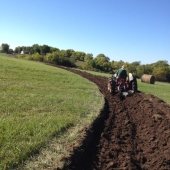Well, I just dug my first swale. The ditch is about 3.5 feet wide, and the berm is about 2.5 feet wide (at the base) and 1 foot tall (in the middle). It was originally dug with a two-turn plow, then manually cleaned up with a shovel and rake. It's implemented exactly as I'd hoped, which was a pleasant surprise.
But now that I actually have it in front of me, the real life dimensions are a little surprising to me. Mainly, the the berm just seems too tall and skinny and has me wondering if the trees will enjoy this topography. I could knock it down a bit before planting the trees (which are due to arrive next week).
I'm planning on using this on-contour swale to plant nursery stock of fruit trees - apple, pear, peach, cherry, plum, and pawpaw. But how does the root structure work on this tall skinny berm? Will the roots dig in deep, and not wide? Is that a good thing? Besides the risk of the berm washing out, is there anything else I need to worry about with my swale dimensions?
And one final question: Is there much I can do at this time of year to prevent the swale washing out before I have more plants with roots to strengthen the berm wall? I was thinking that I would need to have a drain pipe to keep the swale empty until next Spring. Is that a good idea?













 1
1




 )
)




 1
1




 2
2




 ).
).





